Uncertainty Principle and Power Quality Sensing and Analysis in Smart Substation
Abstract
1. Introduction
- It is unknown how many kinds of PQ can be sensed.
- It is unknown what kinds of PQ are sensed.
- Accurate features of PQ are needed to study what causes the PQ.
2. Influence of Uncertainty Principle on Power Quality Sensing and Analysis
2.1. Uncertainty Principle of Power Quality Sensing
2.2. Uncertainty Principle and Accuracy of Power Quality Analysis in Substation
3. Ideal Atomic Decomposition by Orthogonal Matching Pursuit
3.1. Ideal Atomic Decomposition of Time and Frequency
3.2. Realization of Ideal Atomic Decomposition by Orthogonal Matching Pursuit for Power Quailty Sensing
3.3. Power Quality Analysis Based on Ideal Atomic Decomposition Sensing
3.3.1. Transient Power Quality Analysis
3.3.2. Short-Duration Power Quality Analysis
3.3.3. Steady Power Quality Analysis
- IAD senses the PQ in a pair of time and frequency bases, and Equation (1) can be realized, which can hardly be done by many traditional methods because of Equation (2). Consequently, with minimized and , PQ sensing by IAD is more faithful than traditional methods.
4. Simulation of Typical Power Quality Sensing and Analysis
4.1. Transient and Steady Power Quality Test
4.2. Short-Duration Power Quality Test
4.3. Power Quality with Strong Noise Test
4.4. Flicker and Interharmonics PQ Test
4.5. Notch Test
5. Field Power Quality Sensing and Analysis in Smart Substation
5.1. Events of Voltage Sag Analysis
5.2. Event of Harmonic Analysis
5.3. Event of Multi-Oscillation Analysis
5.4. Event of Complex Power Quality Analysis
5.5. Customer-Caused Failure of Irreuglar Power Quality Analysis
- (1)
- Both time features and frequency features can be sensed faithfully at the same time, and the analysis of the features can be accurate, consequently.
- (2)
- The features have specific physical meaning in time–frequency for the event of PQ revealing.
- (3)
- Prior knowledge of the measured PQ is not necessary.
- (4)
- Nonlinear component interference is not included.
6. Conclusions
Author Contributions
Funding
Conflicts of Interest
References
- Huang, Q.; Jing, S.; Li, J.; Cai, D.; Wu, J.; Zhen, W. Smart substation: State of the art and future development. IEEE Trans. Power Deliv. 2017, 17, 1098–1105. [Google Scholar] [CrossRef]
- Wang, Z.; Perera, A. Integrated platform to design robust energy internet. Appl. Energy 2020, 268, 114942–114954. [Google Scholar] [CrossRef]
- Shahzad, Y.; Javed, H.; Farman, H.; Ahmad, J.; Jan, B.; Zubair, M. Internet of energy: Opportunities, applications, architectures and challenges in smart industries. Comput. Electr. Eng. 2020, 86, 106739–106753. [Google Scholar] [CrossRef]
- Chan, J.Y.; Milanovic, J.V.; Delahunty, A. Generic failure-risk assessment of industrial processes due to voltage sags. IEEE Trans. Power Syst. 2009, 24, 2405–2414. [Google Scholar] [CrossRef]
- Zhang, W.; Xiao, X.; Kai, Z.; Xu, W.; Jing, Y. Multicycle incipient fault detection and location for medium voltage underground cable. IEEE Trans. Power Deliv. 2017, 32, 1450–1459. [Google Scholar] [CrossRef]
- Ghandehari, R.; Shoulaie, A. Evaluating voltage notch problems arising from AC/DC converter operation. IEEE Trans. Power Elec. 2009, 24, 2111–2119. [Google Scholar] [CrossRef]
- Joon-Ho, K.; Jin, O.K. Analysis and mitigation on switching transients of medium-voltage low-harmonic filter banks. Energies 2020, 19, 2187–2201. [Google Scholar]
- The Institute of Electrical and Electronics Engineers, Inc. Standard IEEE 1159-2009: IEEE Recommended Practice for Monitoring Electric Power Quality; IEEE: New York, NY, USA, 2009. [Google Scholar]
- International Electrotechnical Commission. Standard IEC 61000-4-30:2003: Electromagnetic Compatibility (EMC)–Part 4–30: Testing and Measurement Techniques–Power Quality Measurement Methods; IEC: Geneva, Switzerland, 2003. [Google Scholar]
- He, S.; Li, K.; Zhang, M. A real-time power quality disturbances classification using hybrid method based on S-transform and dynamics. IEEE Trans. Instrum. Meas. 2013, 62, 2465–2475. [Google Scholar] [CrossRef]
- Beuter, C.; Oleskovicz, M. S-transform: From main concepts to some power quality applications. IET Signal Proces. 2020, 14, 115–123. [Google Scholar] [CrossRef]
- Lin, C.; Wang, C. Adaptive wavelet networks for power-quality detection and discrimination in a power system. IEEE Trans. Power Deliv. 2006, 21, 1106–1113. [Google Scholar] [CrossRef]
- Cho, H.; Jang, G.; Kwon, H. Time-frequency analysis of power-quality disturbances via the Gabor-Wigner transform. IEEE Trans. Power Deliv. 2010, 25, 494–499. [Google Scholar]
- Wright, P. Short-time Fourier transforms and Wigner-Ville distributions applied to the calibration of power frequency harmonic analyzers. IEEE Trans. Instrum. Meas. 1999, 48, 475–478. [Google Scholar] [CrossRef]
- Chen, C.; Chang, G.; Hong, R.; Li, H. Extended real model of Kalman filter for time-varying harmonics estimation. IEEE Trans. Power Deliv. 2010, 32, 17–26. [Google Scholar] [CrossRef]
- He, S.; Li, K.; Zhang, M. A new transient power quality disturbances detection using strong trace filter. IEEE Trans. Instrum. Meas. 2014, 63, 2863–2871. [Google Scholar] [CrossRef]
- Peng, J.; Nair, N. Adaptive sampling scheme for monitoring oscillations using Prony analysis. IET Gener. Transm. Distrib. 2009, 3, 1052–1060. [Google Scholar] [CrossRef]
- Gu, I.; Bollen, M. Estimating interharmonics by using sliding-window ESPRIT. IEEE Trans. Power Deliv. 2008, 23, 13–23. [Google Scholar] [CrossRef]
- Wang, S.; Chen, H. A novel deep learning method for the classification of power quality disturbances using deep convolutional neural network. Appl. Energy 2020, 235, 1126–1140. [Google Scholar] [CrossRef]
- Donoho, D.; Huo, X. Uncertainty principles and ideal atomic decomposition. IEEE Trans. Inf. Theory 2001, 47, 2845–2862. [Google Scholar] [CrossRef]
- DeBrunner, V.; Ozaydın, M.; Przebinda, T. Resolution in time-frequency. IEEE Trans. Signal Process. 1999, 47, 783–788. [Google Scholar] [CrossRef]
- Ślesicka, A.; Kawalec, A. An application of the orthogonal matching pursuit algorithm in space-time adaptive processing. Sensors 2020, 20, 3468. [Google Scholar] [CrossRef]
- Stockwell, R.; Mansinha, L.; Lowe, R. Localization of the complex spectrum: The S transform. IEEE Trans. Signal Process. 1999, 44, 998–1001. [Google Scholar] [CrossRef]
- Costa, F. Boundary wavelet coefficients for real-time detection of transients induced by faults and power-quality disturbances. IEEE Trans. Power Deliv. 2014, 29, 2674–2687. [Google Scholar] [CrossRef]
- International Electrotechnical Commission. Standard IEC 61000-4-15. Electromagnetic Compatibility (EMC)–Part 4-15: Testing and Measurement Techniques–Flickermeter-Functional and Design Specification; IEC: Geneva, Switzerland, 1997. [Google Scholar]
- The Institute of Electrical and Electronics Engineers, Inc. Standard IEEE 519-1992. IEEE Recommended Practices and Requirements for Harmonic Control in Electrical Power Systems; IEEE: New York, NY, USA, 1993. [Google Scholar]
- International Electrotechnical Commission. Standard IEC 61850-9-1. Communication Networks and Systems in Substations–Part 9-1: Specific Communication Service Mapping–Sampled Values Over Serial Unidirectional Multidrop Point to Point Link; IEC: Geneva, Switzerland, 2003. [Google Scholar]
- Koch, B.; Christophe, P. Arc voltage for arcing faults on 25(28)-kV cables and splices. IEEE Trans. Power Deliv. 1993, 8, 779–788. [Google Scholar] [CrossRef]
- Smith, D.; Swanson, S.; Borst, J. Overvoltages with remotely-switched cable-fed grounded wye-wye transformers. IEEE Trans. Power Appar. Syst. 1975, 94, 1843–1853. [Google Scholar] [CrossRef]
- Zhang, Y.; Yang, H.; Wang, J.; Geng, Y.; Liu, Z.; Jin, L.; Yu, L. Influence of high-frequency high-voltage impulse conditioning on back-to-back capacitor bank switching performance of vacuum interrupters. IEEE Trans. Plasma Sci. 2016, 44, 321–333. [Google Scholar] [CrossRef]
- National Disturbance Library by IEEE PES. Available online: https://pqmon.epri.com/disturbance_library/ (accessed on 30 July 2020).


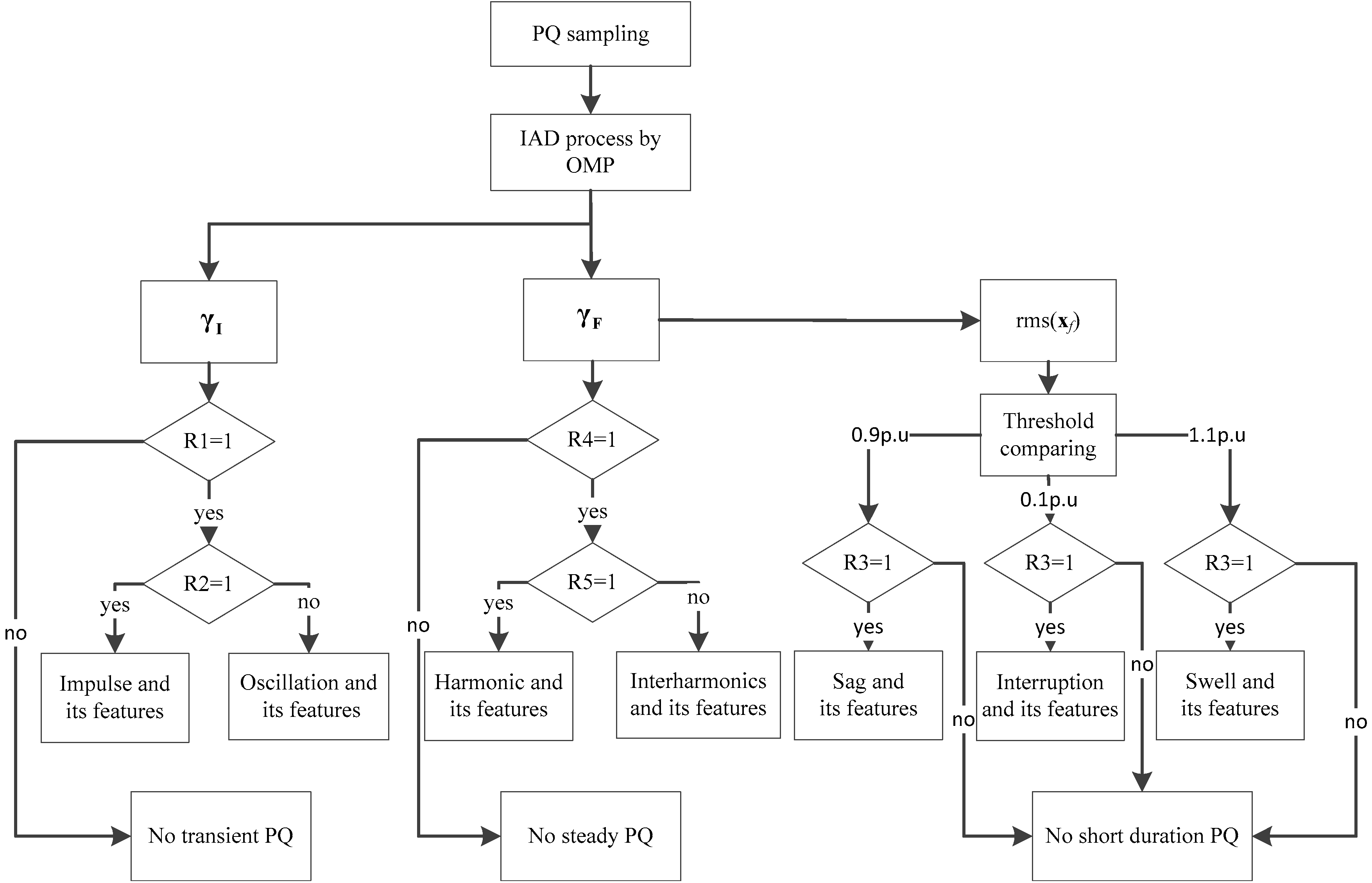
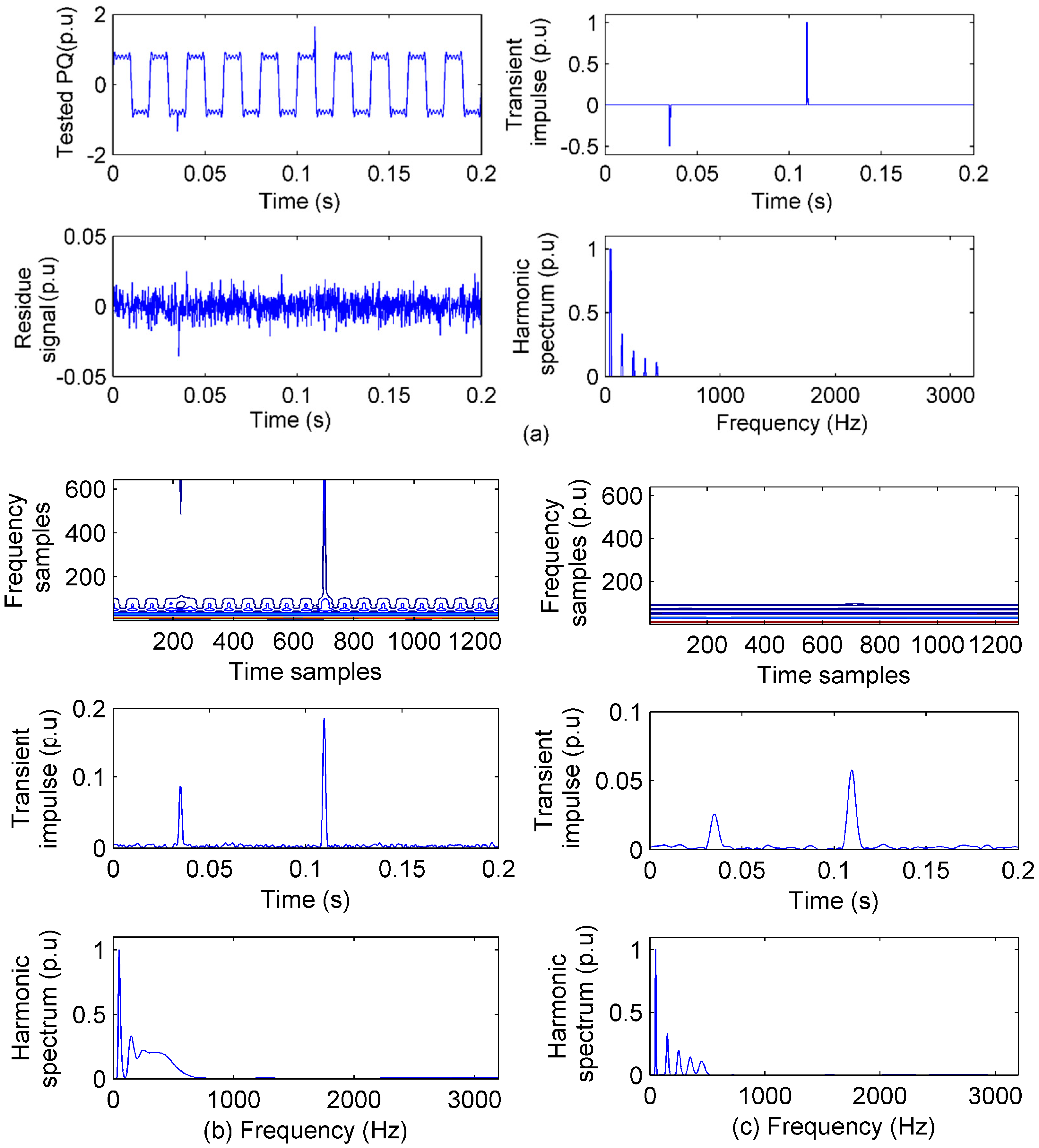
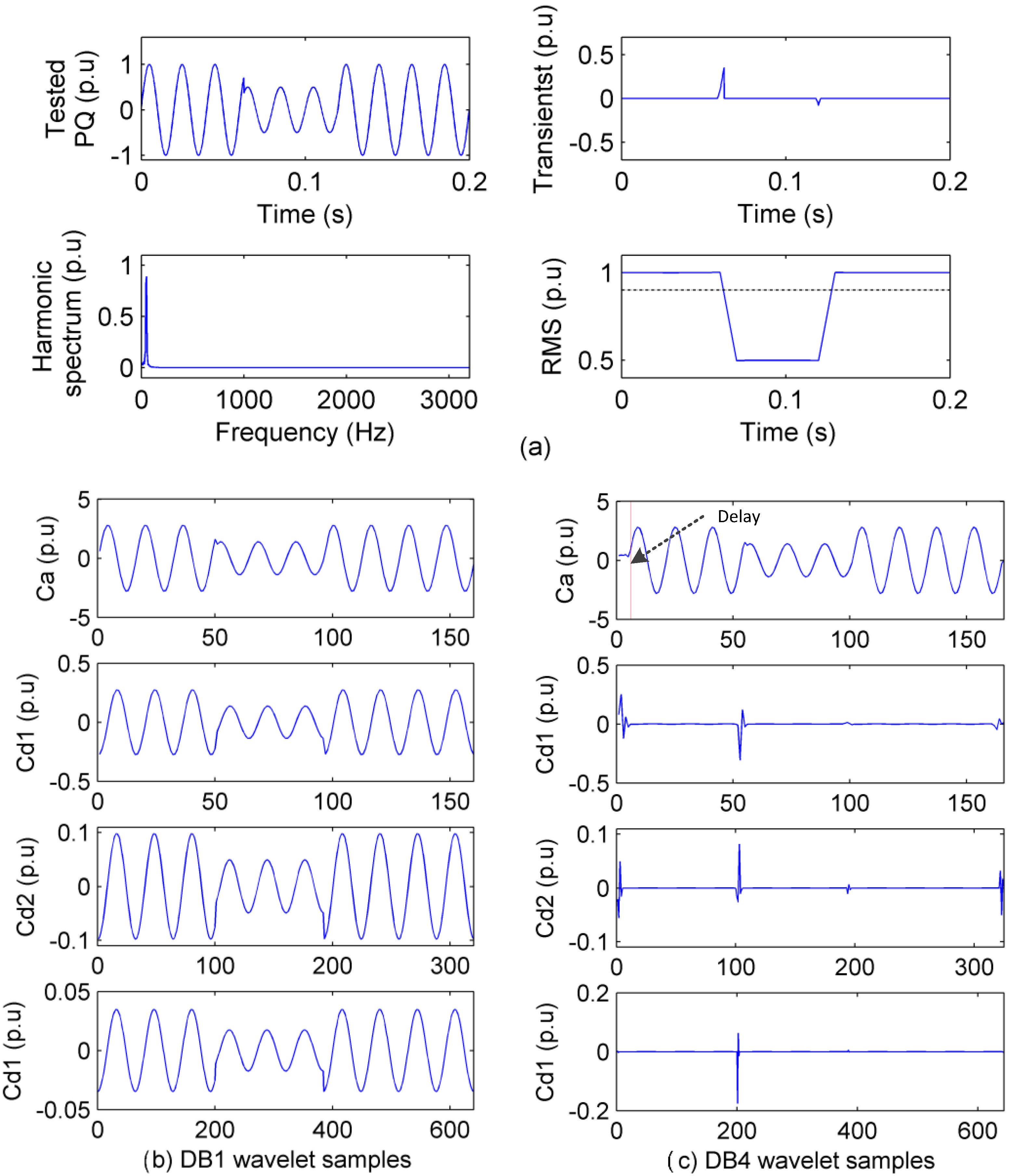
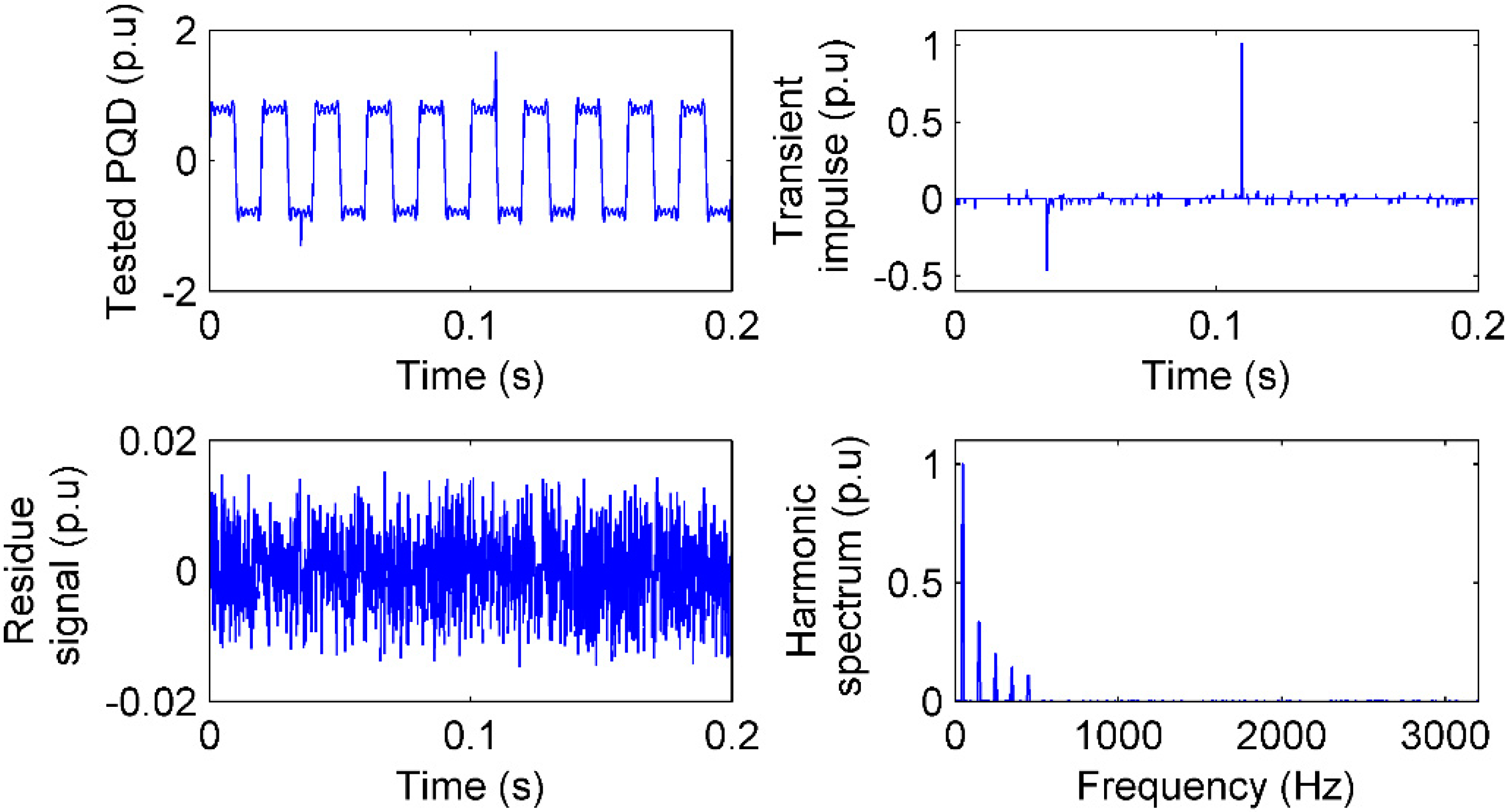
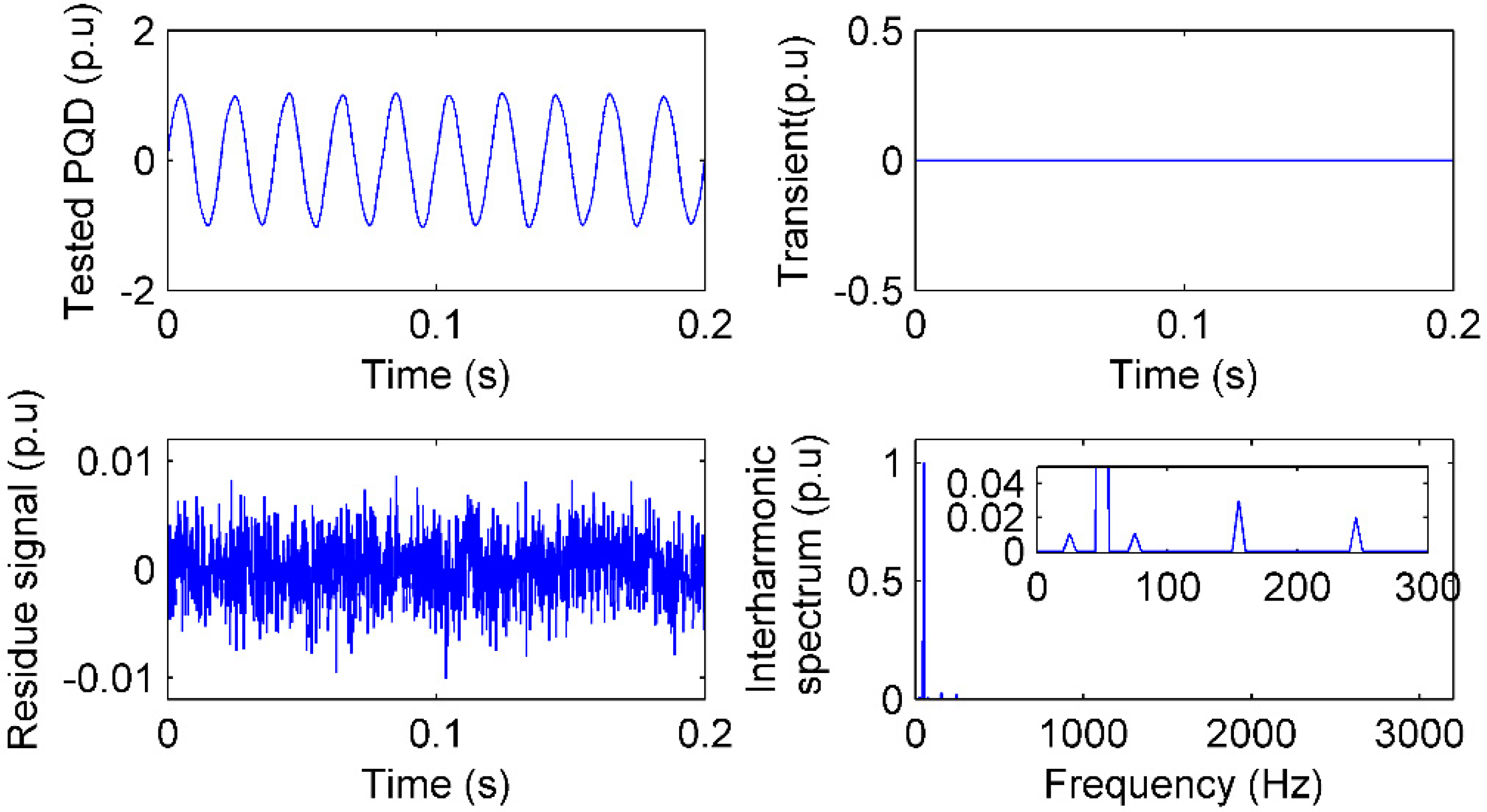
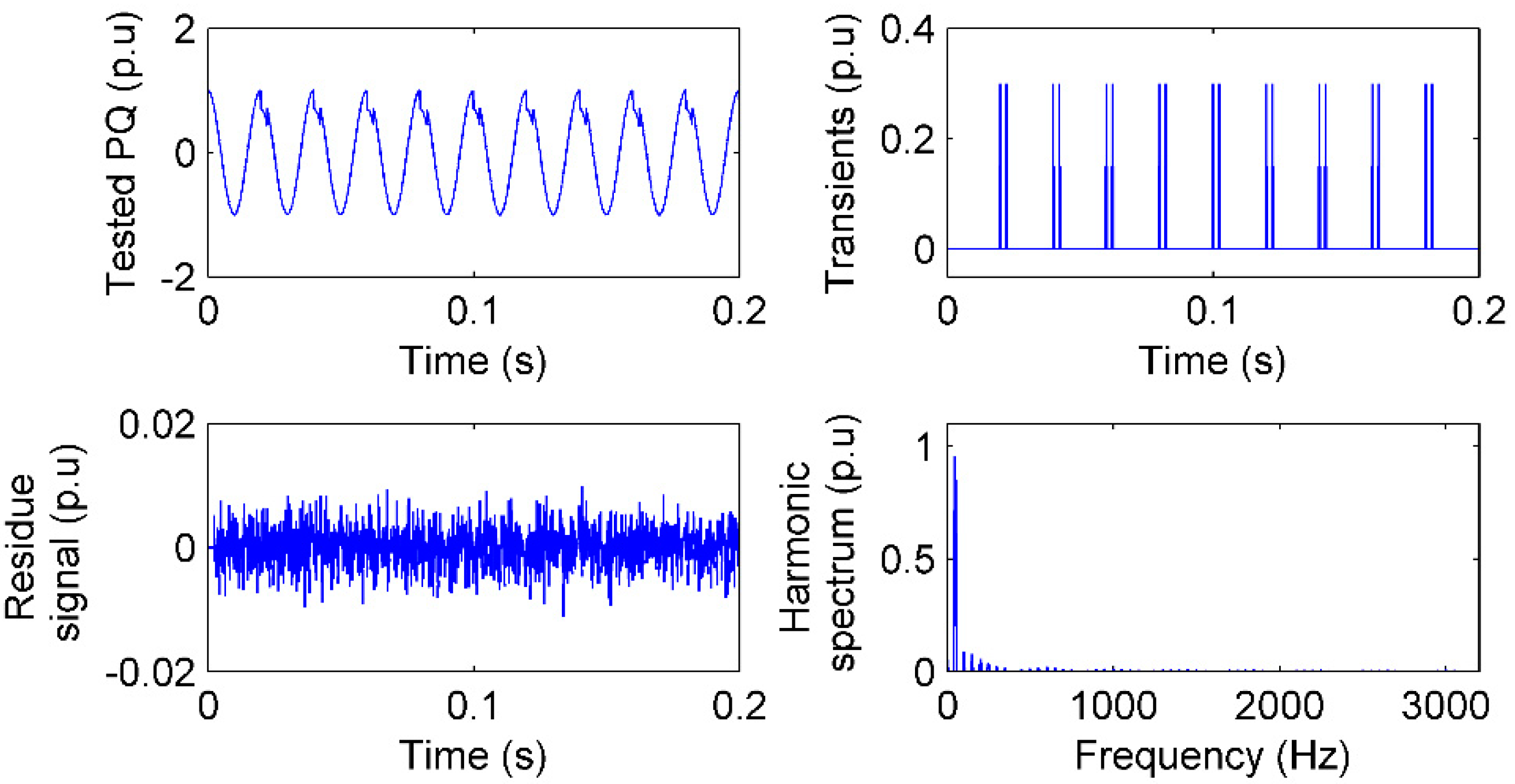

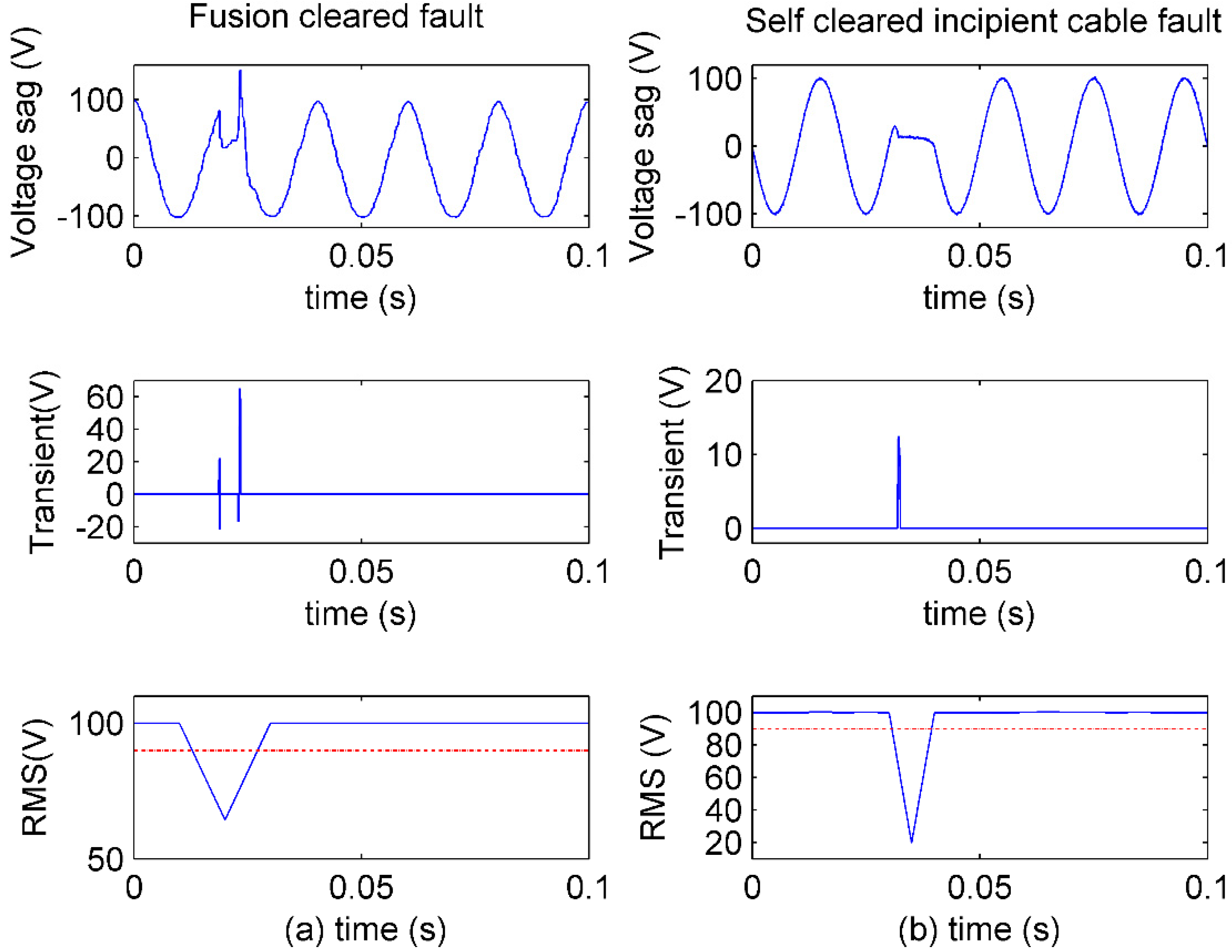
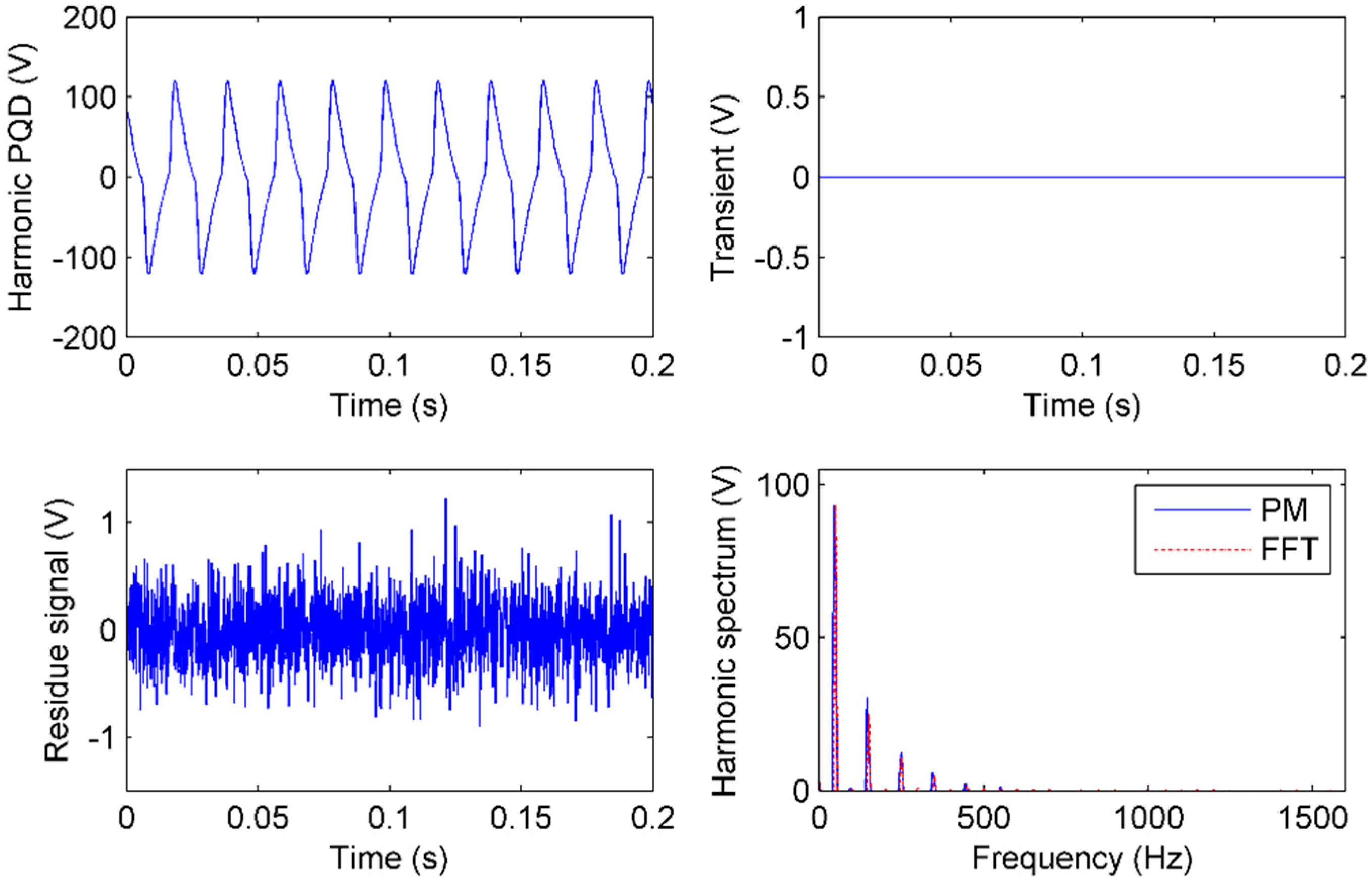

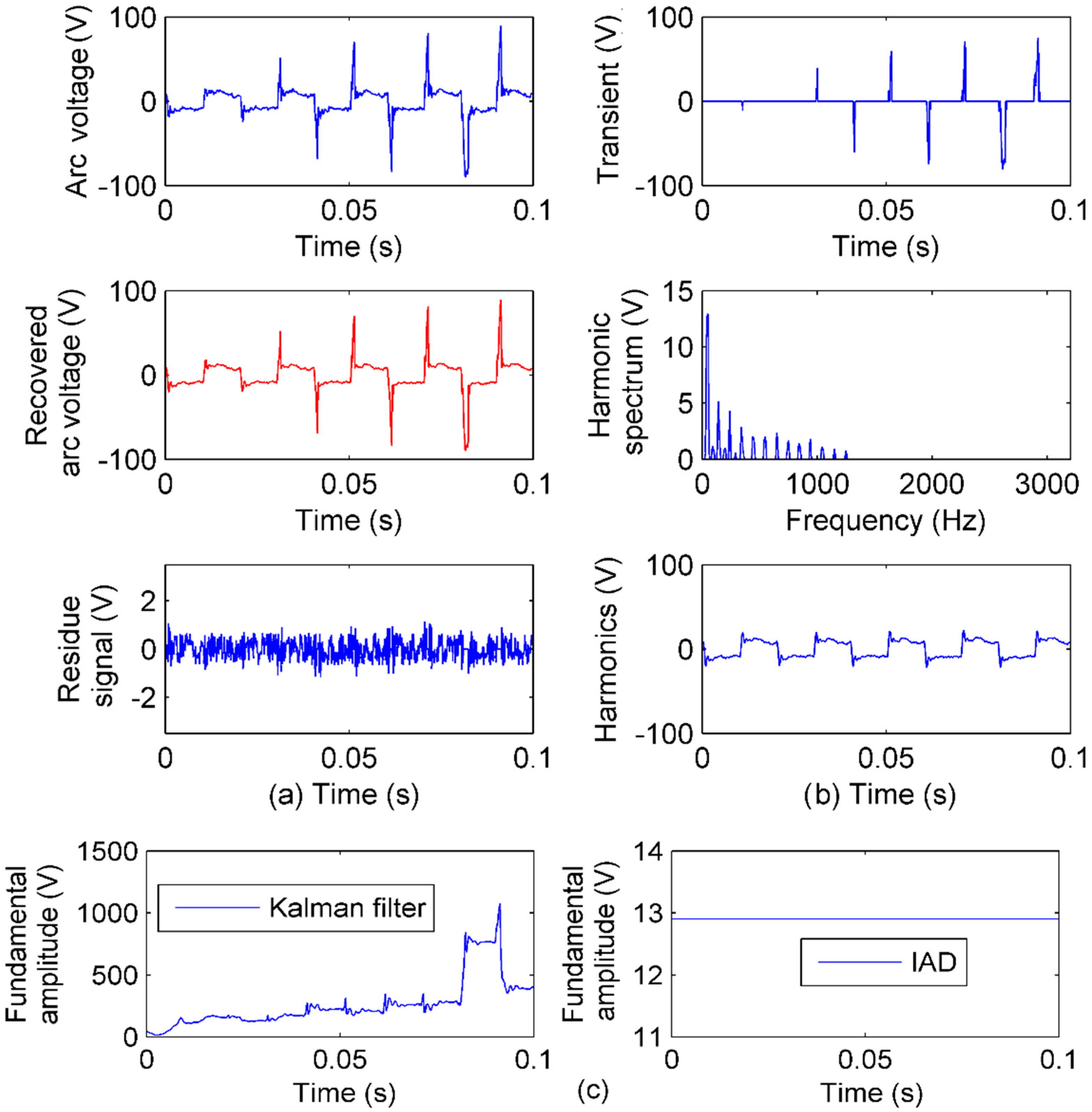
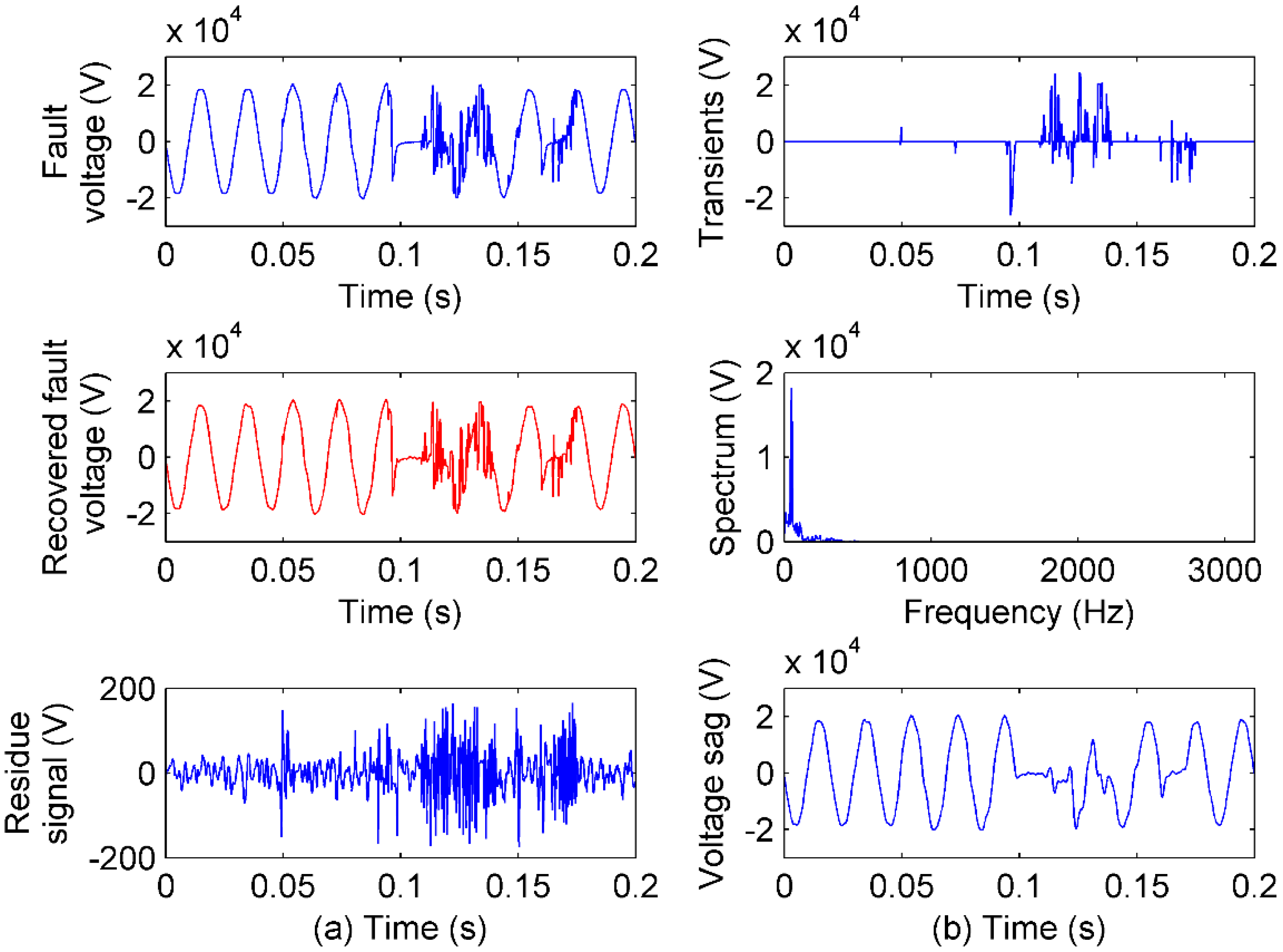
| Method Class | Representative Methods | Advantage | Disadvantage |
|---|---|---|---|
| Non-parameter estimation: Linear methods | S transform [10,11], Wavelet transform [12], Gabor transform [13]. | (1) Both time features and frequency features can be sensed. (2) Features have specific physical meaning. (3) Prior knowledge of the measured PQ is not necessary. | (1) Both sensing of time features and frequency features are unfaithful because of the uncertainty principle. |
| Non-parameter estimation: Non-linear methods | Time–frequency distribution [14]. | (1) Both time features and frequency features can be sensed. (2) Prior knowledge of the measured PQ is not necessary. (3) The influence of uncertainty principle is excluded. | (1) Feature sensing is with cross-terms, and can hardly be used along for PQ analysis [13]. |
| Parameter estimation | Kalman filter [15,16], Prony [17]. | (1) Both time features and frequency features can be sensed. (2) Features have specific physical meaning. (3) The influence of uncertainty principle is excluded. | (1) Precise prior knowledge of the measured PQ is needed. If the PQ does not comply with the model of parameter estimation, the features sensing is unfaithful. |
| Singular spectrum analysis | Esprit [18]. | (1) The influence of uncertainty principle is excluded. | (1) The features do not have specific physical meaning. (2) Prior knowledge of the measured PQ is needed for the window set of spectrum analysis |
| Deep learning | Convolutional neural network [19]. | (1) Prior knowledge of the measured PQ is not necessary. (2) The influence of uncertainty principle is excluded. | (1) The features do not have specific physical meaning and are not explainable. (2) A large amount of data are needed for the training. |
| Impulse1 | Impulse 2 | Harmonics Amplitudes | |||||||||
|---|---|---|---|---|---|---|---|---|---|---|---|
| (p.u) | (ms) | (ms) | (p.u) | (ms) | (ms) | (p.u) | |||||
| b | tk | Duration | b | tk | Duration | 1st | 3rd | 5th | 7th | 9th | |
| True | −0.5 | 35 | 3.3 | 1 | 110 | 1 | 1 | 0.33 | 0.2 | 0.14 | 0.11 |
| IAD | −0.503 | 35 | 3.2 | 1.012 | 110 | 1 | 1.001 | 0.330 | 0.201 | 0.139 | 0.112 |
| ST1 | 0.085 | 33 | 3.8 | 0.18 | 107 | 3 | 1.005 | 0.331 | - | - | - |
| ST2 | 0.031 | 33 | 11 | 0.06 | 105 | 10 | 1.001 | 0.330 | 0.181 | 0.129 | 0.100 |
| Voltage Sag | Sag Depth (p.u) | Start Time (ms) | Duration (ms) |
|---|---|---|---|
| True | 0.5 | 65 | 45 |
| IAD | 0.5 | 63 | 48 |
| DWT1 | 0.44 | 63 | 48 |
| DWT2 | 0.49 | 70 | 49 |
© 2020 by the authors. Licensee MDPI, Basel, Switzerland. This article is an open access article distributed under the terms and conditions of the Creative Commons Attribution (CC BY) license (http://creativecommons.org/licenses/by/4.0/).
Share and Cite
Cai, W.; Wu, L.; Cui, Y.; He, S. Uncertainty Principle and Power Quality Sensing and Analysis in Smart Substation. Sensors 2020, 20, 4281. https://doi.org/10.3390/s20154281
Cai W, Wu L, Cui Y, He S. Uncertainty Principle and Power Quality Sensing and Analysis in Smart Substation. Sensors. 2020; 20(15):4281. https://doi.org/10.3390/s20154281
Chicago/Turabian StyleCai, Wanli, Li Wu, Yibo Cui, and Shunfan He. 2020. "Uncertainty Principle and Power Quality Sensing and Analysis in Smart Substation" Sensors 20, no. 15: 4281. https://doi.org/10.3390/s20154281
APA StyleCai, W., Wu, L., Cui, Y., & He, S. (2020). Uncertainty Principle and Power Quality Sensing and Analysis in Smart Substation. Sensors, 20(15), 4281. https://doi.org/10.3390/s20154281




